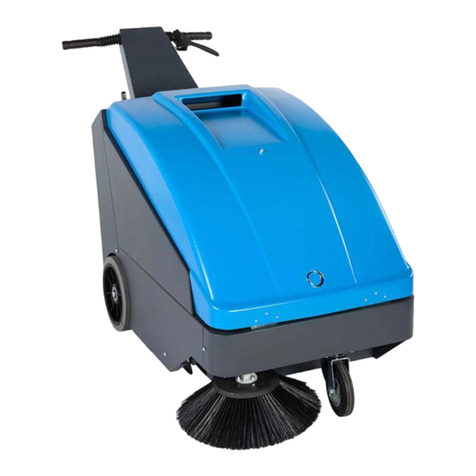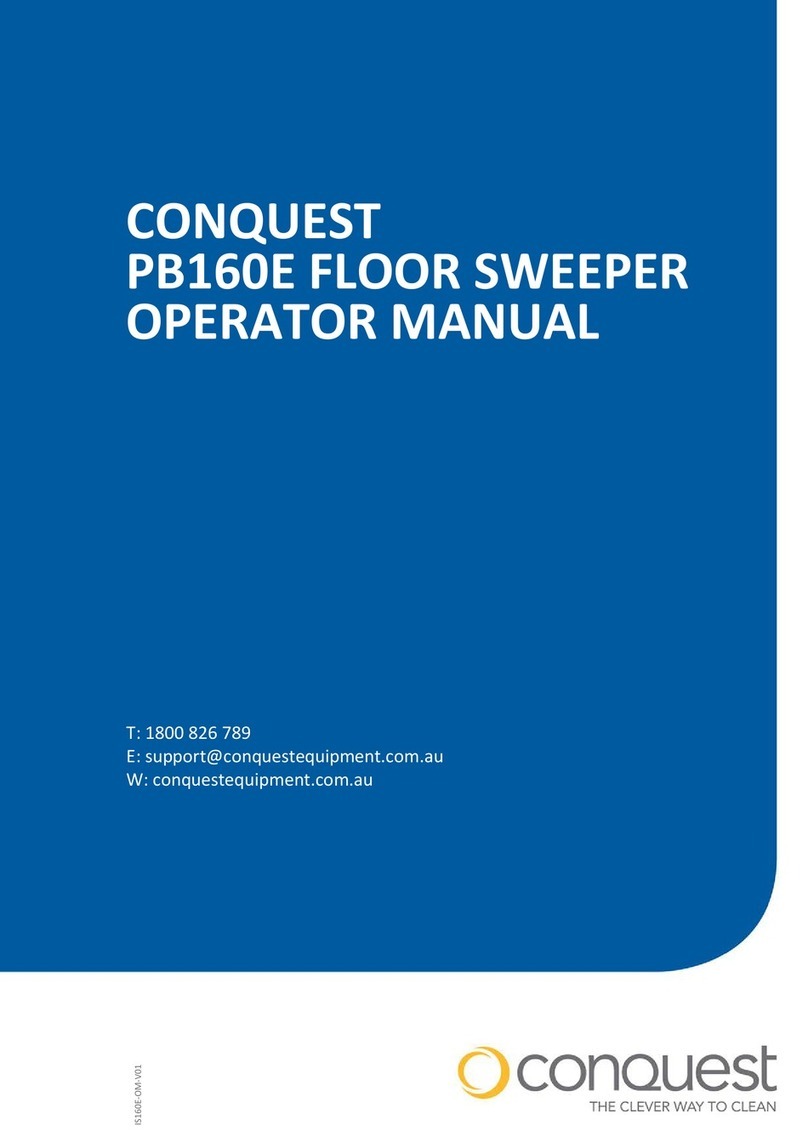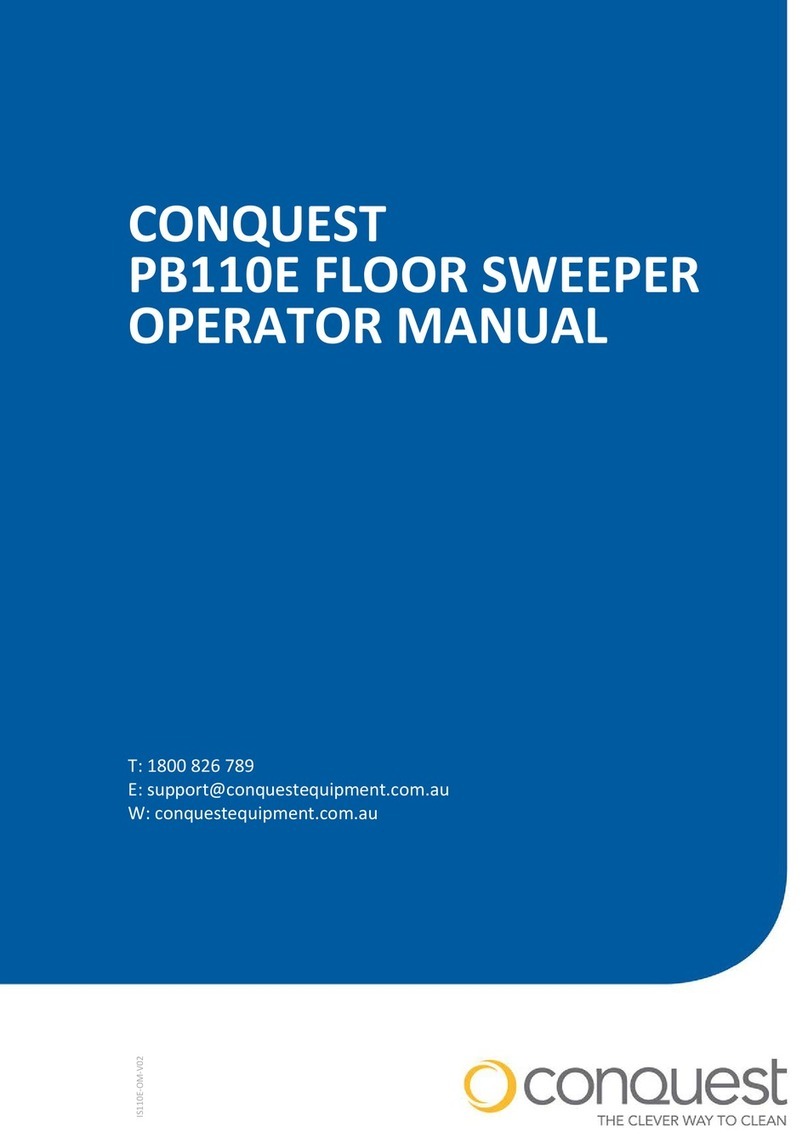-2
Use this sweeper only as directed in these
operating instructions.
– This sweeper has been designed to
sweep dirt and debris from outdoor sur-
faces.
– The machine is not suitable for being
driven on public roads.
– Any use extending beyond this is not
considered as proper use. The manu-
facturer is not liable for any losses re-
sulting from this; the user alone bears
the risk for this.
–(Gas motor)
The device is permitted for operation in
confined spaces with sufficient ventila-
tion.
(Applicable for Germany only)
In Germany, the operation of gas motor
devices in confined spaces is prohibit-
ed.
– Gas bottles and appliance may only be
stored on ground level.
– The machine may not be modified.
– The machine is only suitable for use on
the types of surfaces specified in the
operating instructions.
– The machine may only be operated on
the surfaces approved by the company
or its authorised representatives.
– The following applies in general: Keep
highly-flammable substances away
from the appliance (danger of explo-
sion/fire).
– Never vacuum up explosive liquids,
combustible gases or undiluted acids
and solvents. This includes petrol, paint
thinner or heating oil which can gener-
ate explosive fumes or mixtures upon
contact with the suction air. Acetone,
undiluted acids and solvents must also
be avoided as they can harm the mate-
rials on the machine.
– Never sweep/vacuum up reactive metal
dusts (e.g. aluminium, magnesium,
zinc), as they form explosive gases
when they come in contact with highly
alkaline or acidic detergents.
– The appliance is not suitable for sweep-
ing off hazardous substances.
– Do not sweep/vacuum up any burning
or glowing objects.
– The machine may not be used or stored
in hazardous areas. It is not allowed to
use the appliance in hazardous loca-
tions.
– It is strictly prohibited to take co-pas-
sengers.
– Pushing/pulling or transporting objects
by means of this appliance is prohibit-
ed.
– Asphalt
– Industrial floor
– Screed
– Concrete
– Paving stones
(ApplicableforFinlandonly)Thedevice
may not be used at low ambient tem-
peratures (below 0°C) if it is equipped
with a PVC hose line. Contact ISAL if
you should have questions regarding
your device.
The machine with working equipment
must be checked to ensure that it is in
proper working order and is operating
safely prior to use. Otherwise, the appli-
ance must not be used.
If the appliance is used in hazardous ar-
eas (e.g. filling stations) the corre-
sponding safety provisions must be ob-
served. It is not allowed to use the ap-
pliance in hazardous locations.
DANGER
Risk of injury!
Do not use the appliance without an
overhead guard in areas where the op-
erator might get hit by falling objects.
The operator must use the appliance
properly. The person must consider the
local conditions and must pay attention
to third parties, in particular children,
when working with the appliance.
It is important to follow all safety instruc-
tions, rules and regulations applicable
for driving motor vehicles.
Prior to starting work, the operator must
ensure that all protective devices are
properly installed and function correctly.
The operator of the appliance is liable
for accidents with other individuals or
their property.
Ensure that the operator wears tight-fit-
ting clothes. Wear sturdy shoes and
avoid wearing loose-fitting clothes.
Check the immediate vicinity prior to
starting (e.g. children). Ensure suffi-
cient visibility!
Never leave the machine unattended
so long as the engine is running. The
operator may leave the appliance only
when the engine has come to a stand-
still, the appliance has been protected
against accidental movement, and the
key has been removed.
Please remove the key, when not in
use, to avoid unauthorised use of the
appliance.
The appliance may only be used by per-
sons who have been instructed in han-
dling the appliance or have proven
qualification and expertise in operating
the appliance or have been explicitly
assigned the task of handling the appli-
ance.
This appliance is not intended for use
by persons (including children) with lim-
ited physical, sensoric or mental capac-
ities or lack of experience and/or skills,
unless such persons are accompanied
andsupervisedbyapersoninchargeof
their safety or if they received precise
instructions on the use of this appli-
ance.
Children should be supervised to pre-
vent them from playing with the appli-
ance.
CAUTION
Risk of damage! Do not sweep up straps,
strings or wires as these may wrap around
the brush roller.
DANGER
Risk of injury! Verify the stability of the
ground prior to driving on it.
DANGER
Risk of accident, risk of injury!
The travel speed must be adapted to
the existing conditions.
Danger of tipping if gradient is too high.
The gradient in the direction of travel
should not exceed 18%.
Danger of tipping on unstable ground.
Only use the machine on sound surfaces.
Danger of tipping with excessive sideways
tilt.
The gradient perpendicular to the direc-
tion of travel should not exceed 10%.
Hauptverband der gewerblichen Beruf-
sgenossenschaften e.V. (HVBG / Germa-
ny). Liquefied gases (propellants) are bu-
tane and propane or a mixture of butane/
propane. They are available in special cyl-
inders. The operating pressure of these
gases depends on the outside tempera-
ture.
Danger
Risk of explosion! Do not handle liquified
gas like petrol. Petrol evaporates slowly,
liquified gas immediately turns into gas.
The risk of gas spreading in the room and
getting ignited is thus higher in case of liq-
uefied gas than in petrol.
Danger
Risk of injury! Use only liquefied gas cylin-
ders with propellant filled according to DIN
51622 of A or B quality, depending on the
surrounding temperature.
CAUTION
Useofcookinggasisstrictlyprohibited.For
the gas engine, use only liquid gas mix-
tures of propane/ butane or their mixtures
where the mixing ratio lies between 90/10
to 30/70. On account of better cold start be-
haviour even at low outside sub-zero tem-
peratures (below 0° C / 32 °F) always pre-
fer a mixture with a higher propane share
because evaporation takes place even at
low temperatures.
– All persons handling liquid gases are li-
able to acquaint themselves with the
special properties of the liquefied gases
for hazard-free handling of operations.
The current documentation is always to
be kept with the sweeper.
Proper use
Foreseeable misuse
Suitable surfaces
Safety instructions
Safety instructions concerning the
operation
Safety information concerning the
driving operation
Safety regulations for LPG vehicles
Liabilities of the factory management
and the employee
































